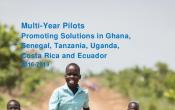United Republic of Tanzania
Operation: United Republic of Tanzania
Location
{"longitude":35,"latitude":-6,"zoom_level":0,"iso_codes":"'TZA'"}
By clicking on the icons on the map, additional information is displayed.
Key Figures
| 2017 year-end results | |
| 38,950 | people were sensitized and trained on SGBV |
| 8,490 | transitional shelters and 7,195 emergency shelters constructed |
| 4,820 | people of concern had their cases submitted for resettlement |
| 970 | identified sexual and gender-based violence (SGBV) survivors were assisted with appropriate support including psychosocial and legal support |
| 2018 planning figures | |
| 100% | of Congolese refugees identified in need of resettlement will have their cases submitted for resettlement |
| 85% | of primary school-aged Burundian refugee children will be enrolled in primary school |
| 75% | of Congolese refugees (18-59 years) with own business/self-employment for more than 12 months |
| 60% | of Burundian refugee households will be living in adequate dwellings |
| 1,160 | Congolese refugees per each hygiene promoter |
| 26 | liters of potable water will be available per person per day |
| 0.5 | Crude mortality rate (per 1,000 population/month) for Burundian refugees |
More Information
People of Concern
20%
Increase in
2016
2016
| 2016 | 458,828 |
| 2015 | 382,620 |
| 2014 | 252,357 |

[["Refugees",281498],["Asylum-seekers",8539],["Returned refugees",6],["Others of concern",168785]]
Loading ...
United Republic of Tanzania
< Back
2017
{"categories":[2013,2014,2015,2016,2017,2018],"budget":[39.65703876,38.21491383,134.15516444,108.50987822,137.1331802,125.8620637],"expenditure":[19.39590816,24.6811937,48.87004149,69.99019142,66.46673125,null]}
{"categories":[2013,2014,2015,2016,2017,2018],"p1":[15.86371529,23.19500923,118.73635308,96.04563581,126.70166642,122.6414574],"p2":[null,null,null,null,null,null],"p3":[23.79332347,15.0199046,15.41881136,12.46424241,10.43151378,3.2206063],"p4":[null,null,null,null,null,null]}
{"categories":[2013,2014,2015,2016,2017,2018],"p1":[13.24639973,20.0803866,42.24403878,65.51548653,61.88418214,null],"p2":[null,null,null,null,null,null],"p3":[6.14950843,4.6008071,6.62600271,4.47470489,4.58254911,null],"p4":[null,null,null,null,null,null]}
Loading ...
CHOOSE A YEAR
- 2014
- 2015
- 2016
- 2017
- 2018
Operational context
The United Republic of Tanzania—which hosted the largest number of Burundian refugees—lifted prima facie refugee status recognition for refugees and asylum-seekers from Burundi at the beginning of 2017. The country called for the resumption of individual refugee status determination (RSD), sometimes leading to a restrictive approach to granting asylum or in congestion at reception centers. The protection environment became complex, resulting in increasing restrictions in access to territory and closure of some border entry points.As one of the roll-out countries for the Comprehensive Refugee Response Framework (CRRF), the United Republic of Tanzania launched a Secretariat in June 2017 to reaffirm its commitment to the five pledges made during the Leaders’ Summit in 2016.
While UNHCR is not promoting voluntary return to Burundi, it has supported the operation to ensure returns are based on the principles of voluntariness and informed decisions; and take place in safety and dignity. By the end of 2017, more than 13,100 Burundian have been assisted to voluntarily repatriate to Burundi.
The United Republic of Tanzania is also a Multi-Year and Multi-Partner (MYMP) pilot country and has developed it strategy with a view to finding durable solutions for most refuges in the next years.
Population trends
At the end of 2017, the United Republic of Tanzania hosted over 359,000 asylum-seekers and refugees, of which over 88 per cent reside in refugee camps. Burundian refugees and asylum-seekers who constitute over 77 per cent of the camp population reside in Nduta (118,640), Mtendeli (45,530) and Nyarugusu (69,850). Nyarugusu is also host to close to 82,200 Congolese and some 250 refugees from other nationalities.Tensions and conflicts in South Kivu and Kasai provinces in the Democratic Republic of the Congo and uncertainties in the political situation in Burundi fuelled the continued flow of new asylum-seekers in the United Republic of Tanzania, in smaller numbers than in the previous two years.
Births among the populations contributed to a 4 per cent increase in the overall population. Women and children make up 77 per cent of all people of concern; while children alone account for 55 per cent.
Some 1,580 people (1,400 Congolese and 180 Burundians) were resettled to third countries in 2017. The Congolese were resettled as part of a five-year Group Resettlement Programme aimed at resettling approximately 33,000 Congolese refugees to the United States of America.
Key achievements
- Some 420 community leaders and 38,930 people were sensitized and trained on SGBV.
- An assessment of liquid petroleum gas pilot for some 3,260 households indicated that families reduced consumption of firewood and risk of collection.
- The Office developed a MYMP protection and solutions strategy in line with the whole society approach with key partners to formulate its vision and priority areas for planning purposes.
- The construction of transitional shelters improved the conditions of Burundian refugees in camps.
Unmet needs
Due to the lack of funding, UNHCR could not reach the targets set for primary education, shelter, health and sanitation. For example, family latrines could not be constructed for all families therefore posing protection risks for women and girls and potential future outbreak of diseases.Working environment
The United Republic of Tanzania (Tanzania) has generously hosted millions of refugees, including by granting citizenship to over 162,000 former Burundian refugees in 2014.Political tension in Burundi has caused over 158,000 Burundians to flee to Tanzania since April 2015, bringing the total refugee population in North-Western Tanzania to over 228,000 refugees. The influx necessitated the re-opening of two former camps: Mtendeli and Nduta, thus easing the congestion in the Nyarugusu camp.
The Government has pledged to review the Refugee National Legal Framework, in line with international standards, with the new draft policy due to be finalized in 2017, followed by a revision of the Refugee Act.
UNHCR anticipates a steady number of new arrivals, with the crisis in Burundi likely to continue in 2017 and minimal prospects of voluntary repatriation to Burundi and the Democratic Republic of the Congo (DRC). Resettlement will continue to be a durable solution, especially in protracted situations.
Key priorities
In 2017, UNHCR’s operation will focus on:- Strengthening the refugee status determination (RSD) process;
- Preventing and responding to sexual and gender-based violence (SGBV);
- Increase access to education for refugee children;
- Address immediate shelter needs especially for new arrivals and group resettlement of the protracted Congolese caseload;
- Supporting the finalization of the naturalization of over 1900 pending cases of former Burundian refugees in the Katavi, Kigoma and Tabora regions.



